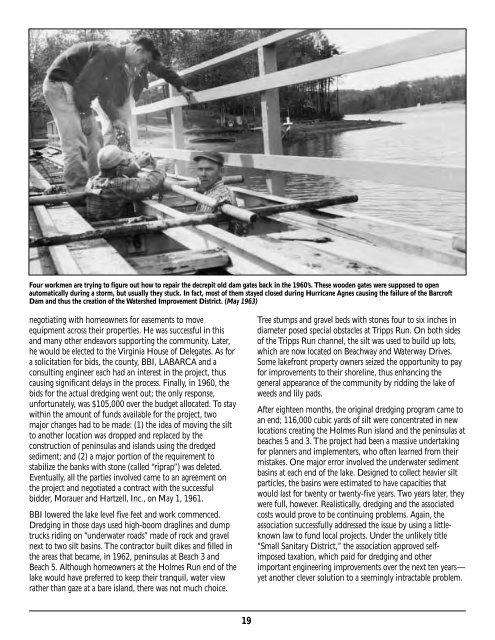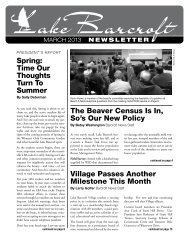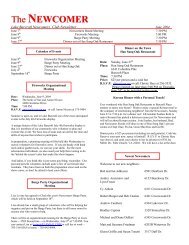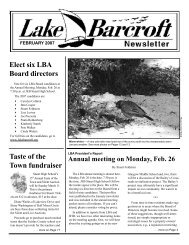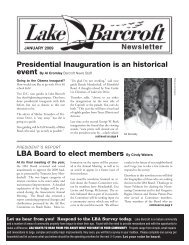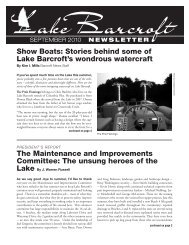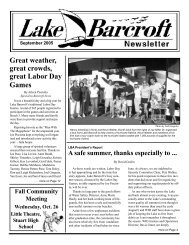Lake Barcroft History Book
Lake Barcroft History Book
Lake Barcroft History Book
You also want an ePaper? Increase the reach of your titles
YUMPU automatically turns print PDFs into web optimized ePapers that Google loves.
Four workmen are trying to figure out how to repair the decrepit old dam gates back in the 1960’s. These wooden gates were supposed to open<br />
automatically during a storm, but usually they stuck. In fact, most of them stayed closed during Hurricane Agnes causing the failure of the <strong>Barcroft</strong><br />
Dam and thus the creation of the Watershed Improvement District. (May 1963)<br />
negotiating with homeowners for easements to move<br />
equipment across their properties. He was successful in this<br />
and many other endeavors supporting the community. Later,<br />
he would be elected to the Virginia House of Delegates. As for<br />
a solicitation for bids, the county, BBI, LABARCA and a<br />
consulting engineer each had an interest in the project, thus<br />
causing significant delays in the process. Finally, in 1960, the<br />
bids for the actual dredging went out; the only response,<br />
unfortunately, was $105,000 over the budget allocated. To stay<br />
within the amount of funds available for the project, two<br />
major changes had to be made: (1) the idea of moving the silt<br />
to another location was dropped and replaced by the<br />
construction of peninsulas and islands using the dredged<br />
sediment; and (2) a major portion of the requirement to<br />
stabilize the banks with stone (called “riprap”) was deleted.<br />
Eventually, all the parties involved came to an agreement on<br />
the project and negotiated a contract with the successful<br />
bidder, Morauer and Hartzell, Inc., on May 1, 1961.<br />
BBI lowered the lake level five feet and work commenced.<br />
Dredging in those days used high-boom draglines and dump<br />
trucks riding on “underwater roads” made of rock and gravel<br />
next to two silt basins. The contractor built dikes and filled in<br />
the areas that became, in 1962, peninsulas at Beach 3 and<br />
Beach 5. Although homeowners at the Holmes Run end of the<br />
lake would have preferred to keep their tranquil, water view<br />
rather than gaze at a bare island, there was not much choice.<br />
19<br />
Tree stumps and gravel beds with stones four to six inches in<br />
diameter posed special obstacles at Tripps Run. On both sides<br />
of the Tripps Run channel, the silt was used to build up lots,<br />
which are now located on Beachway and Waterway Drives.<br />
Some lakefront property owners seized the opportunity to pay<br />
for improvements to their shoreline, thus enhancing the<br />
general appearance of the community by ridding the lake of<br />
weeds and lily pads.<br />
After eighteen months, the original dredging program came to<br />
an end; 116,000 cubic yards of silt were concentrated in new<br />
locations creating the Holmes Run island and the peninsulas at<br />
beaches 5 and 3. The project had been a massive undertaking<br />
for planners and implementers, who often learned from their<br />
mistakes. One major error involved the underwater sediment<br />
basins at each end of the lake. Designed to collect heavier silt<br />
particles, the basins were estimated to have capacities that<br />
would last for twenty or twenty-five years. Two years later, they<br />
were full, however. Realistically, dredging and the associated<br />
costs would prove to be continuing problems. Again, the<br />
association successfully addressed the issue by using a littleknown<br />
law to fund local projects. Under the unlikely title<br />
“Small Sanitary District,” the association approved selfimposed<br />
taxation, which paid for dredging and other<br />
important engineering improvements over the next ten years—<br />
yet another clever solution to a seemingly intractable problem.


